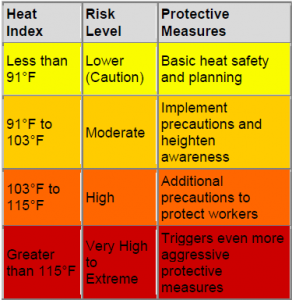A color-coded data table depicting the risk levels and recommended protective measures associated with various levels of heat exposure.
Know the Signs of Heat Illness
Training employees to recognize the signs of heat-related illnesses is part of the education process for construction safety. Hopefully, through proper prevention, you or an employee won’t ever need to use this training in real life, but it’s part of being prepared.
- Heat Rash – Clusters of red bumps due to sweat accumulation will appear in creases of the employees’ skin. While a heat rash is not life threatening, it should be treated. Use powder to dry the affected area, and have the employee remain in the shade.
- Heat Cramps – Employee will experience sharp pains and cramping in the abdomen. Allow them to rest and drink water until the cramping goes away. If the cramping persists, seek medical attention.
- Heat Exhaustion – If an employee is experiencing heavy sweating, headache, nausea or vomiting, dizziness, light headedness, and irritability, take them to a medical clinic immediately and do not allow them to return to work until the next day.
- Heat Stroke – A heat stroke is life-threatening. If an employee is experiencing confusion, fainting, seizures, and a high body temperature, call 911 immediately. While waiting for the ambulance, loosen and remove outer clothing, and place ice packs in armpits. Provide fluids and wait with the employee until the ambulance arrives.
Educate Your Employees on Prevention
Education and prevention shouldn’t begin and end with you. Your employees also need to understand how to protect themselves from the heat, and know when it’s time to take a break.
- Water – Have portable drinking water on or near the site. Direct employees to take small, frequent sips.
- Avoid Diuretics – Drinks such as coffee, sodas, and alcohol will cause employees to become dehydrated. Stick to water or sports drinks with electrolytes.
- Take breaks – It seems obvious, but taking breaks in the shade helps to keep body temperature down.
- Use precaution with heavy clothing – For employees who must wear heavy clothing and masks, use ice packs, dry ice, or special ventilation hoses to keep the inside of their uniforms cool.
- Know the signs – Know the warning signs of heat-related illnesses listed above.
Look Out for New Employees
New employees are especially susceptible to heat-related illnesses. In 2005, Cal/OSHA investigated 25 incidents of heat-related illness. In almost half of the cases, it was the injured employees’ first day of work. In 80% of the cases, employees had only been on the job for four or fewer days. If it’s an employees’ first week on the job, make sure they’ve had the right heat prevention training and understand what it takes to stay protected. It is recommended that you start them out doing only 50% of their workload, and then gradually give them more throughout the week.
You have a responsibility to your employees. Encourage a positive safety culture, where everyone knows the signs and looks out for each other. Happy summer, and remember: “Water. Rest. Shade.”





